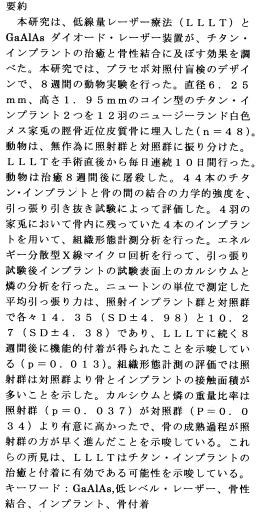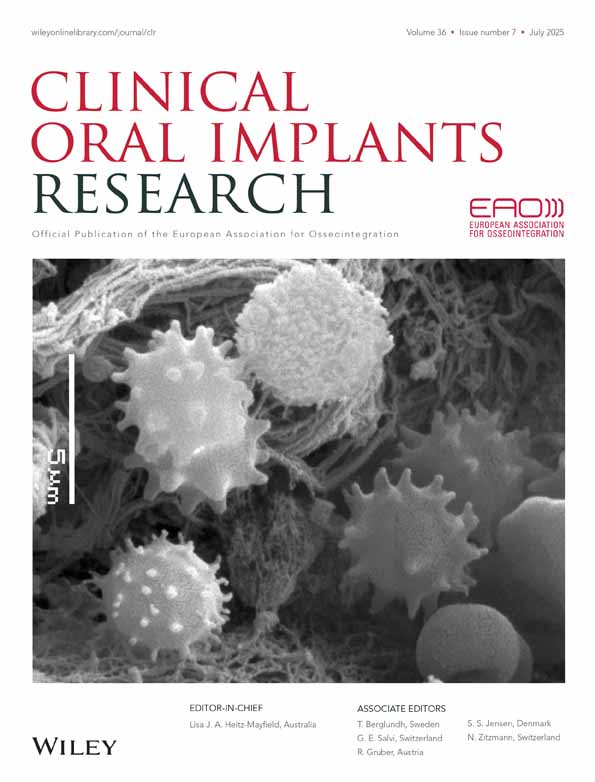Low-level laser therapy stimulates bone–implant interaction: an experimental study in rabbits
Abstract
enAbstract: The aim of the present study was to investigate the effect of low-level laser therapy (LLLT) with a gallium-aluminium-arsenide (GaAlAs) diode laser device on titanium implant healing and attachment in bone. This study was performed as an animal trial of 8 weeks duration with a blinded, placebo-controlled design. Two coin-shaped titanium implants with a diameter of 6.25 mm and a height of 1.95 mm were implanted into cortical bone in each proximal tibia of twelve New Zealand white female rabbits (n=48). The animals were randomly divided into irradiated and control groups. The LLLT was used immediately after surgery and carried out daily for 10 consecutive days. The animals were killed after 8 weeks of healing. The mechanical strength of the attachment between the bone and 44 titanium implants was evaluated using a tensile pullout test. Histomorphometrical analysis of the four implants left in place from four rabbits was then performed. Energy-dispersive X-ray microanalysis was applied for analyses of calcium and phosphorus on the implant test surface after the tensile test. The mean tensile forces, measured in Newton, of the irradiated implants and controls were 14.35 (SD±4.98) and 10.27 (SD±4.38), respectively, suggesting a gain in functional attachment at 8 weeks following LLLT (P=0.013). The histomorphometrical evaluation suggested that the irradiated group had more bone-to-implant contact than the controls. The weight percentages of calcium and phosphorus were significantly higher in the irradiated group when compared to the controls (P=0.037) and (P=0.034), respectively, suggesting that bone maturation processed faster in irradiated bone. These findings suggest that LLLT might have a favourable effect on healing and attachment of titanium implants.
Résumé
frLe but de l'étude présente a été d'étudier l'effet d'un traitement au laser de faible intensité (LLLT) avec une diode GaAlAs sur la guérison des implants en titane et leur attache dans l'os. Cette étude a été effectuée lors d'un essai animal de huit semaines avec un modèle contrôlé par placebo et en aveugle. Deux implants en titane en forme de pièce avec un diamètre de 6,25 mm et une hauteur de 1,95 mm ont été implantés dans l'os cortical de chaque tibia de douze lapines blanches de Nouvelle-Zélande (n=48). Elles ont été réparties au hasard entre un groupe irradié et un groupe contrôle. Le LLLT a été utilisé immédiatement après la chirurgie et poursuivi chaque jour durant douze jours consécutifs. Les animaux ont été euthanasiés après huit semaines de guérison. La force mécanique de l'attache entre l'os et les 44 implants en titane a étéévaluée par un test d'enlèvement. L'analyse histomorphométrique des quatres implants laissés en place chez quatre lapines a ensuite été effectué. La microanalyse par RX par dispersion d'énergie a été appliquée pour les analyses du calcium et du phosphore sur la surface testée de l'implant après le test d'enlèvement. Les forces moyennes d'enlèvement, mesurées en Newton, d'implants irradiés et contrôles étaient respectivement de 14,5±5 et 10,3±4,4 N, suggérant un gain dans l'attache fonctionnelle à huit semaines suivant le LLLT (p=0,013). L'évaluation histomorphométrique a suggéré que le groupe irradié avait davantage de contact os-implant que le contrôle. Les pourcentages de poids de calcium et de phosphore étaient significativement plus importants dans le groupe irradié que dans le contrôle (respectivement p=0,037 et p=0,034) suggérant que la maturation osseuse se produisait plus rapidement dans l'os irradié. Ces résultats suggérent que le LLLT pourrait avoir un effet favorable sur la guérison et l'attache des implants en titane.
Zusammenfassung
deLow Level Lasertherapie stimuliert die Knochen-Implantat-Interaktion: eine experimentelle Studie an Kaninchen
Es war das Ziel der vorliegenden Studie, den Einfluss der low Level Lasertherapie (LLLT) mit einem GaAlAs Diodenlasergerät auf die Einheilung von Titanimplantaten und die Anhaftung im Knochen zu untersuchen. Die Studie wurde als Tierexperiment über einen Zeitraum von 8 Wochen mit einem blinden, placebokontrollierten Versuchsaufbau durchgeführt. Zwei münzförmige Titanimplantate mit einem Durchmesser von 6,25 mM und einer Höhe von 1.95 mM wurden in den kortikalen Knochen der proximalen Tibia von 12 weiblichen weissen Neuseelandkaninchen eingesetzt (n=48). Die Tiere wurden zufällig in eine bestrahlte und in eine Kontrollgruppe eingeteilt. Die LLLT wurde unmittelbar nach dem chirurgischen Eingriff angewendet und danach täglich an den zehn darauf folgenden Tagen durchgeführt. Nach einer Heilungszeit von 8 Wochen wurden die Tiere geopfert. Die mechanische Stärke der Verbindung zwischen Knochen und 44 Titanimplantaten wurde durch Zugfestigkeitstests ermittelt. Vier Implantate von 4 Kaninchen wurden belassen und histomorphometrisch analysiert. Nach dem Zugfestigkeitstest wurde der Kalzium- und Phosphorgehalt auf der Implantatoberfläche mittels energiedispersiver Röntgenmikroanalyse ausgewertet. Die mittleren Zugkräfte, gemessen in Newton, betrugen für die bestrahlten Implantate 14.35 (SD±4.98) und für die Kontrollimplantate 10.27 (SD±4.38). Dies lässt einen Gewinn an funktioneller Verbindung nach 8 Wochen durch die LLLT vermuten (P=0.013). Die histomorphometrische Untersuchung zeigte vermutlich mehr Knochen-Implantat-Kontakt bei der bestrahlten als bei der Kontrollgruppe. Die Gewichtsprozente von Kalzium und Phosphor waren bei der bestrahlten Gruppe signifikant grösser als bei der Kontrolle (P=0.037 bzw. P=0.034). Das lässt vermuten, dass die Knochenreifung im bestrahlten Knochen schneller voranschritt. Diese Resultate lassen vermuten, dass die LLLT einen positiven Effekt auf die Einheilung und die Anhaftung von Titanimplantaten haben könnte.
Resumen
esLa intención del presente estudio fue investigar el efecto de la terapia con láser de bajo nivel (LLLT) con dispositivo láser diodo de GaAlAs sobre la cicatrización de implantes de titanio y su inserción al hueso. Este estudio se llevó a cabo como un estudio animal de 8 semanas de duración con un diseño de placebo controlado. Se implantaron dos implantes de titanio, con forma de moneda con un diámetro de 6.25 mm y una altura de 1.95 mm, en el hueso cortical de cada tibia proximal de doce conejos hembra de Nueva Zelanda (n=48). Los animales se dividieron al azar en grupos irradiados y de control. El LLLT se usó inmediatamente tras la cirugía y se llevó a cabo diariamente durante 10 días consecutivos. Los animales se sacrificaron tras 8 semanas de cicatrización. La fuerza mecánica de la inserción entre hueso y 44 implantes de titanio se evaluó usando un test de tensión de extracción. Entonces se llevó a cabo un análisis histomorfométrico de los 4 implantes dejados en su lugar de 4 conejos. Se aplicó microanálisis de rayos-X de energía dispersa para análisis de calcio y fósforo en la superficie de prueba del implante tras el test de tensión. Las fuerzas de tensión medias, medidas en Newtons, de los implantes irradiados y los de control fueron 14.35 (SD ± 4.98) y 10.27 (SD ± 4.38) respectivamente, sugiriendo un incremento en el en la inserción funcional a las 8 semanas tras LLLT (p=0.013). La evaluación histomorfométrica sugirió que el grupo irradiado tuvo mayor contacto hueso implante que los controles. Los porcentajes de calcio y fósforo fueron significativamente mayores en el grupo irradiado cuando se comparó con los controles (p=0.037) y (p=0.34) respectivamente sugiriendo que la maduración del hueso se procesó mas rápido en el hueso irradiado. Estos hallazgos sugieren que el LLLT puede tener un efecto favorable en la cicatrización y la inserción de los implantes de titanio.





